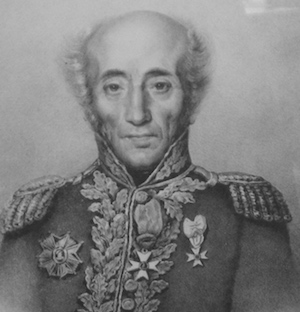General François Ange Alexandre Blein

Born: November 26, 1767
Place of Birth: Bourg-les-Valence, Drôme, France
Died: July 2, 1845
Place of Death: Paris, France
Arc de Triomphe: BLEIN on the north pillar
Pronunciation:
The son of an army surgeon, François Ange Alexandre Blein entered the school of roads and bridges in 1785 and left there in 1789. Next he worked at Tréport and Cherbourg and then at the end of 1792 he joined the Army of the Var. Blein went on to work on the bridge of Var and the defenses of Mont Gros and then in June of 1794 he was promoted to capitaine and assigned to the Army of the Sambre and Meuse. Putting his engineering skills to use, he served at the Siege of Valenciennes in August and then the Siege of Maestricht. In 1795 Blein was employed at Landrecies where he worked on the canal from the Sambre to the Oise. In 1798 he joined the Army of Mainz and then in 1799 he served with the Army of the Danube and the Army of Switzerland. That year Blein took part in the Siege of Philipsbourg, he helped to prepare Mannheim and Kastel for defense, and he was promoted to chef de bataillon. In 1800 he joined the Army of the Rhine and he served at the crossing of the Rhine, Neresheim, and the blockade of Ulm. As the campaign resumed that winter, in December Blein served at Haag and the Battle of Hohenlinden. After that French victory, he took part in the crossing of the Inn and the crossing of the Salza.
In 1801 Blein was named deputy director of fortifications at Saint-Quentin. In 1803 he joined Berthier's staff in the Army of the Coasts of the Ocean and in 1805 he was attached to the headquarters of the Grande Armée. Taking part in the campaign of 1805, Blein served at Wertingen in October and the Battle of Austerlitz in December. A few weeks later he received a promotion to colonel. In 1806 Blein served with the general staff and he took part in the Battle of Jena. That December he was named commander of the engineers of IX Corps and he began directing the Siege of Breslau. Blein went on to direct the sieges of Brieg, Schweidnitz, Kosel and Silberberg.
Blein was recognized as a Knight of Military Merit of Württemberg and in 1808 he was named a Baron of the Empire. Sent to Spain, he took command of the engineers assigned to headquarters and he served at Somosierra and the action of Madrid. Blein was next sent on a mission to Galicia and then at the end of January he assisted at the action of Ferrol. In March he was called to the Army of Germany where he became chief of staff of engineers of the army. That April he served at Thann, was wounded at Landshut, served at Eckmühl, and was wounded at Ratisbon. Continuing to see action during the campaign, Blein served at the action of Vienna, the Battle of Aspern-Essling , the Battle of Wagram , and then at Znaïm.
In 1810 and 1811 Blein served as director of fortifications of Cherbourg. In 1812 he joined Marshal Oudinot's II Corps and he took part in the campaign in Russia. After surviving the retreat, in 1813 Blein served on the campaign in Saxony and he was promoted to général de brigade in July. In August he took command of the engineers of Oudinot's XII Corps, in November he took command of the engineers of three corps, and then at the end of the year he took command of the engineers of VI Corps. During the defense of France of 1814, Blein served in Champagne and he was named a Commander of the Legion of Honor.
Blein did not take an active part in the Hundred Days of 1815 that saw Napoleon resuming power for a short period of time. Afterwards he retired from the army but in 1831 he returned to the army. Blein was grievously wounded by Fieschi's infernal machine in the attempted assassination of King Louis Philippe in 1835 that killed Marshal Mortier.
Bibliography
- Divry, Arnauld. Les Noms Gravés sur l'Arc de Triomphe. Paris: L'Harmattan, 2017.
- Six, Georges. Dictionnaire Biographique des Généraux & Amiraux Français de la Révolution et de l'Empire (1792-1814). 2 vols. Paris: Gaston Saffroy, 2003.
Updated July 2020
© Nathan D. Jensen